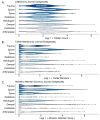#OrthoTwitter: Relationship Between Author Twitter Utilization and Academic Impact in Orthopaedic Surgery
- PMID: 36814734
- PMCID: PMC9939849
- DOI: 10.7759/cureus.33978
#OrthoTwitter: Relationship Between Author Twitter Utilization and Academic Impact in Orthopaedic Surgery
Abstract
Background #OrthoTwitter has evolved to disseminate findings and engage the public. However, the academic impact of Twitter utilization in orthopaedic surgery is unknown. Questions/purposes The purpose of the study was to evaluate relationships between the author and manuscript Twitter activity and citations. Methods Manuscripts in 17 orthopaedic journals from 2018 were identified. Citations, online mentions, impact factors, and subspecialties were obtained. H-index and Twitter account details for authors were obtained for a subset of manuscripts. Relationships between Twitter activity and citations were evaluated. Results 2,473/4,224 (58.5%) manuscripts were mentioned on Twitter (n=29,958 mentions), with Twitter manuscripts cited more frequently (median 10 vs. 7, p<0.0001). Twitter mentions, impact factors, non-open-access status, and subspecialties were associated with citation counts. Articles mentioned in 10, 100, and 1,000 Tweets were observed to have a 1.1-fold, 1.7-fold, and 245-fold increase in citations. In author-level analyses, 156 (20.0%) first and 216 (27.7%) senior authors had Twitter accounts. Citation count was associated with increasing senior author H-index (β est=0.13, p<0.05), Twitter mentions (β est=0.0043, p<0.0001), impact factors (β est=0.13, p<0.0001), and having a first (β est=0.20, p<0.05) or senior author (β est=0.17, p<0.05) on Twitter. Articles published in arthroplasty (β est=0.49, p<0.05), general interest (β est=0.55, p<0.01), sports (β est=0.63, p<0.01), and non-open access journals (β est=0.41, p<0.001) were cited more. H-index correlated with followers for first (rho=0.31, p<0.0001) and senior authors (rho=0.44, p<0.0001). Conclusion Author Twitter utilization is independently associated with manuscript citations. Authors should be aware of the potential association between social media utilization and traditional academic impact. Understanding the relationship between social media utilization and academic impact is necessary to effectively disseminate research.
Keywords: author-level bibliometrics; bibliometric analyis; bibliometric analyses; ortho; ortho surgery; orthopaedic research; orthopaedics; orthopaedics surgery; orthotwitter; twitter.
Copyright © 2023, Halvorson et al.
Conflict of interest statement
The authors have declared that no competing interests exist.
Figures




References
-
- The scholarly influence of orthopaedic research according to conventional and alternative metrics: a systematic review. Evaniew N, Adili AF, Ghert M, Khan M, Madden K, Smith C, Bhandari M. JBJS Rev. 2017;5:0. - PubMed
-
- What’s important: How social media can foster connectedness: voices from the #orthotwitter community. Friedman LG, Menendez ME. J Bone Joint Surg Am. 2021;103:1152–1154. - PubMed
-
- The Altmetric score has a stronger relationship with article citations than journal impact factor and open access status: a cross-sectional analysis of 4022 Sport Sciences articles. Silva DO, Taborda B, Pazzinatto MF, Ardern CL, Barton CJ. J Orthop Sports Phys Ther. 2021;51:536–541. - PubMed
LinkOut - more resources
Full Text Sources
Research Materials
